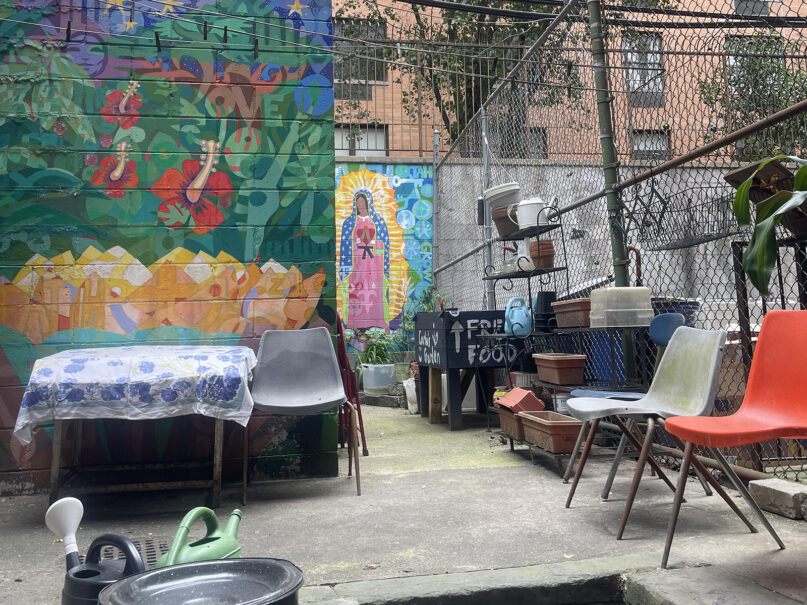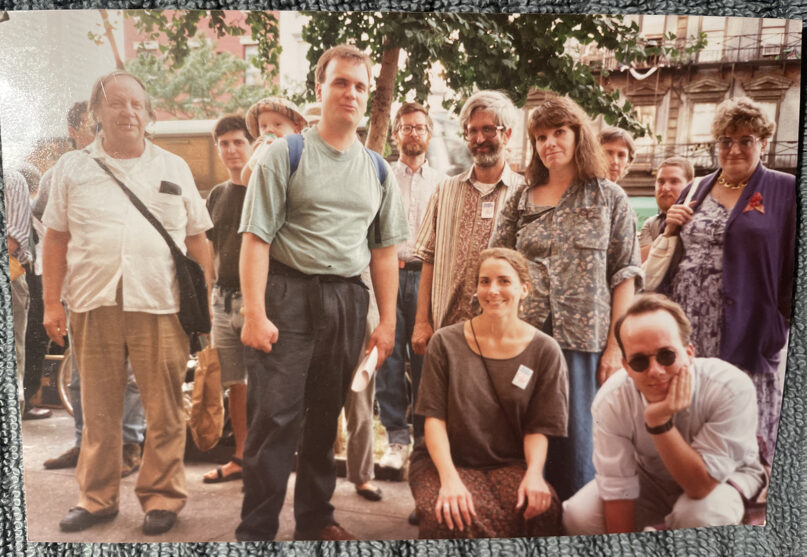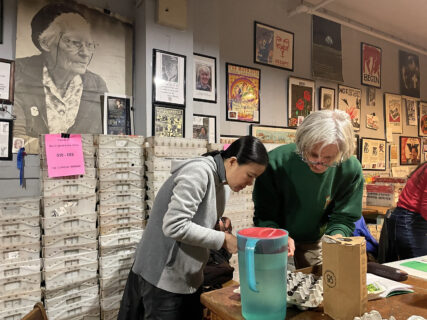NEW YORK (RNS) — Jane Sammon was terrified the first time she met Dorothy Day, the Catholic Worker founder now being considered for sainthood by Rome.
“ I was at the front mopping the floor, and I thought my stomach would drop out,” Sammon said. “It’s like that saying, ‘Jesus is coming look busy,’ you know? Well, Dorothy is coming, look busy!”
It was 1972, and at 25, Sammon had traveled from Cleveland, Ohio, to St. Joseph’s House, a house of hospitality in Manhattan run by Dorothy Day and other members of the Catholic Worker, eager to see a place where Catholics were standing “unequivocally” against the Vietnam War. Staying with friends in Brooklyn, Sammon one day decided to visit St. Joseph’s House on E 1st Street. The rest, she said, is something of a mystery.
Decades later, Sammon is the only member still living in the movement’s New York Houses of Hospitality who lived and worked alongside Day, a woman known worldwide for feeding the poor and advocating for workers’ rights. Since 1933, when The Catholic Worker newspaper was founded, the world around the movement has changed, but Sammon says Day’s presence still looms large.
“ I don’t think anybody else in this house could say they knew Dorothy in the flesh,” Sammon said. “But for me, and this is the big thing, I think we could all know Dorothy Day the way we know Jesus.”
Fifty-three years have passed, and Sammon, 78, has spent most of her life within a two-block radius, living and working at St. Joseph’s House and Maryhouse. The Catholic Worker movement is a community founded by Day in New York through the first houses of hospitality, rooted in voluntary poverty and dedicated to living among and serving the poor in faith and solidarity.
“She’s been a very constant presence in that house,” Martha Hennessy, the granddaughter of Day, said. “She’s been very dedicated to Maryhouse, to the movement and to Dorothy.”
Saturday, Nov. 8, is Dorothy Day’s birthday. Day, with the title “Servant of God,” is currently in the first formal stage in the canonization process. The diocese’s collection of evidence and testimonies about her life has been sent to the Vatican’s Dicastery for the Causes of the Saints for review and approval, at which point Pope Leo would declare her “Venerable,” recognizing she lived a life of heroic virtue. After that, the beatification and canonization process generally requires two miracles attributed to her intercession.

Martha Hennessy, right, Dorothy Day’s granddaughter and a member of New York’s Maryhouse Catholic Worker community, reads an excerpt from her grandmother’s book “On Pilgrimage” in the courtyard of the Vineapple Cafe in New York, Dec. 8, 2021. (RNS photo/Renée Roden)
RELATED: Evidence of Dorothy Day’s ‘everyday’ sainthood heads to Rome, boxed and beribboned
Even after all these years, Sammon’s first encounter with Dorothy stays in her mind. “Her voice… it was very disarming to me,” said Sammon, who, with a mop in hand, recalls that in her mid-20s, she expected the then-75-year-old Day to sound old or possibly crotchety, but she didn’t.
The two shared a brief conversation about who Sammon was and where she was from, and little did either of them know, Sammon would be bringing Day medicine on her deathbed eight years later, in a room four floors above where Sammon lives now. Day died in 1980, just 21 days after her 83rd birthday.
“The last thing she said to me was, ‘and I really want to thank you,’” Sammon said. “And I said, ‘OK, Dorothy.’” At the time, Sammon and Day had lived on the same floor of Maryhouse for several years. “She said it to be comforting, in a way,” Sammon said.
Today, Maryhouse and St. Joseph House still feed hundreds of New Yorkers every week and together house about 50 people. From Tuesday to Friday, Catholic Workers at Maryhouse, some volunteers, others residents, prepare lunch for dozens of vulnerable women.

Lunch service is prepared at Maryhouse in New York City. (RNS photo/Fiona Murphy)
On Friday nights, the auditorium at Maryhouse fills for what Peter Maurin, the French Catholic visionary and co-founder of the movement, called a “Clarification of Thought,” a gathering where activists, filmmakers, musicians, theologians and other thinkers share their ideas and projects.
“Jane is all of our mentor and a pillar in the community,” said Joanne Kennedy, 56, who first came to the New York Catholic Worker in 1995 and later lived at both St. Joseph’s House and Maryhouse. “It’s her home with a lot of other people, but she’s been one long, continuous strand, and that deserves a proper kind of reverence.”
Sammon has written a column for The Catholic Worker newspaper, still printed monthly, since Day’s death in 1980. The column, titled “The Book of Notes,” chronicles everyday life at the Worker and is published under the pen name Ric Rhetor, a play on the word “rhetoric.”
“It is the most popular thing, hands down, the most-read column in the paper on the regular,” said Kennedy. “It’s one of the only things that’s always in it.”
Fellow Catholic Worker Bernie Connaughton, 70, describes an evening in 2000 when he and Sammon were serving sandwiches in a subway station. Connaughton said police began harassing a homeless man on the stairs, and “Jane went right over to the cop and said, ‘Don’t you talk to him that way, officer,’” Connaughton recalls. “’He deserves respect.’”
“She can’t help herself,” Connaughton said. “She can’t stay quiet when she sees something wrong. That can work for good or bad, but it’s who she is.”

The communal backyard of the Catholic Worker’s Maryhouse in New York City. (RNS photo/Fiona Murphy)
Sammon grew up in a devout Catholic family in Cleveland, where her father, Leo, worked as a steam fitter and was involved in the Association of Catholic Trade Unionists. Her mother, Cecilia, who died when Jane was just 11, “had a heart for poor people,” Sammon said. When she was 10 years old, Sammon said her father first told her about Dorothy Day.
Years later, inspired by reading The Catholic Worker newspaper and its call to the works of mercy and its radical stance on peace, Sammon moved to New York with piqued interest. She describes “a trifecta” that drew her to the movement: the Catholic Workers’ genuine love for the Catholic Church, their willingness to live in voluntary poverty and their readiness to risk jail opposing the Vietnam War.
“This idea that your beliefs might have engendered an idea that would cause you to get arrested — and they were willing to do that,” Sammon said. “That was it. And then when I got here, they also had some good fun.”

Jane Sammon, standing second from right, and fellow Catholic Worker community members in a photo from the late 1980s or early 1990s. (Photo courtesy of Sammon)
Sammon now faces health issues that make it difficult for her to walk. She said she does “considerably” less at the Catholic Worker than in years past. She still writes her column and helps organize some Friday night events. She continues to run Maryhouse on Sundays, a tradition she began more than a decade ago to give other residents a day of rest.
Today, new faces come through the Catholic Worker often. Maryhouse hosts an Integral Ecology Circle of approximately 50 members, mostly under age 40, who recently added a rooftop garden to provide fresh food.
RELATED: New York Catholic Workers bring new growth with rooftop garden
“I think I feel like I’m married to this place in a way,” said Sammon, who never married or had children and plans to continue her vow of poverty through the end of her life. “A lot of people find it very hard to understand choosing this lack of material success — to say you don’t want to have it — when there are others who never even had the chance to know whether they could choose that or not.”
“What does it mean to be poor? I think at the Catholic Worker it’s a religious understanding,” she added.
In the archives at Maryhouse, there’s a short recording of a conversation between Sammon and Day, from when Sammon was still in her 20s. Day was speaking with a priest about nonviolence and Catholicism in the office at St. Joseph’s House when Sammon walked in looking for a pair of shoes.
“Dorothy said, ‘Come in, come in, what do you want? You can have anything!’” Sammon said. “I laughed, I said, ‘anything?’”

Decorations adorn Catholic Worker’s St. Joseph’s House in New York City. (RNS photo/Fiona Murphy)
Though Day has been gone for many years, Sammon said there’s no need to dwell on that.
“You’re able to learn from so many people at the Catholic Worker, not only the Dorothy Day person,” Sammon said. “But some woman who walks in, who’s lived out on the street, who just tells you about life in a way that you didn’t know before. And that’s the idea.”
There will be a Mass held at Maryhouse on E 3rd Street at 7 p.m. on Saturday evening, Nov. 8, dedicated to Dorothy Day.





